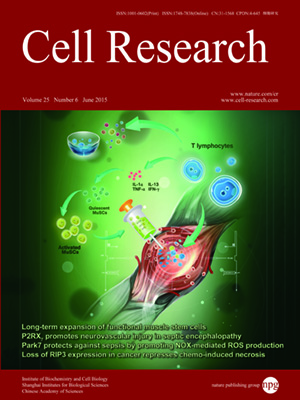
Volume 25, No 6, Jun 2015
ISSN: 1001-0602
EISSN: 1748-7838 2018
impact factor 17.848*
(Clarivate Analytics, 2019)
Volume 25 Issue 6, June 2015: 691-706
ORIGINAL ARTICLES
Park7 interacts with p47phox to direct NADPH oxidase-dependent ROS production and protect against sepsis
Wenjun Liu1,*, Hailong Wu1,*, Lili Chen1, Yankai Wen1, Xiaoni Kong1 and Wei-Qiang Gao1
1State Key Laboratory for Oncogenes and Related Genes, Renji-Med X Clinical Stem Cell Research Center, Ren Ji Hospital, School of Biomedical Engineering, Shanghai Jiao Tong University, Shanghai 200030, China
Correspondence: Xiaoni Kong(xiaonikong@sjtu.edu.cn ; xiaonikong@gmail.com)
Inappropriate inflammation responses contribute to mortality during sepsis. Through Toll-like receptors (TLRs), reactive oxygen species (ROS) produced by NADPH oxidase could modulate the inflammation responses. Parkinson disease (autosomal recessive, early onset) 7 (Park7) has a cytoprotective role by eliminating ROS. However, whether Park7 could modulate inflammation responses and mortality in sepsis is unclear. Here, we show that, compared with wild-type mice, Park7−/− mice had significantly increased mortality and bacterial burdens in sepsis model along with markedly decreased systemic and local inflammation, and drastically impaired macrophage phagocytosis and bacterial killing abilities. Surprisingly, LPS and phorbol-12-myristate-13-acetate stimulation failed to induce ROS and proinflammatory cytokine production in Park7−/− macrophages and Park7-deficient RAW264.7 cells. Through its C-terminus, Park7 binds to p47phox, a subunit of the NADPH oxidase, to promote NADPH oxidase-dependent production of ROS. Restoration of Park7 expression rescues ROS production and improves survival in LPS-induced sepsis. Together, our study shows that Park7 has a protective role against sepsis by controlling macrophage activation, NADPH oxidase activation and inflammation responses.
10.1038/cr.2015.63
FULL TEXT | PDF
Browse 2234


